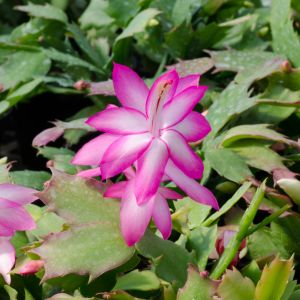Growing a Christmas cactus is a great way to add some festive cheer to your home during the holiday season. These beautiful houseplants are known for their bright, colorful blooms and unique, succulent-like foliage. But if you’re looking to take your Christmas cactus to the next level, you may be wondering how to grow a bigger plant.
This post may contain affiliate links.
Understanding Christmas Cactus
If you’re looking to grow a bigger Christmas cactus, it’s important to understand the plant’s characteristics and requirements. Christmas cacti, also known as Schlumbergera truncata, are native to the tropical forests of South America. They have long, flat, segmented leaves that resemble the shape of a crab claw. The plant’s colorful blooms are usually pink, red, or white and appear during the winter months, making them popular holiday plants.
It’s important to note that there are a few different species of cacti that are commonly referred to as Christmas cacti. In addition to Schlumbergera truncata, there is also the Thanksgiving cactus (Schlumbergera bridgessii) and the Easter cactus (Rhipsalidopsis gaertneri or Hatiora gaertneri). These cacti have similar requirements and care, but their blooming times may vary slightly.
Related Article: When Should I Put My Poinsettia in the Dark? A Quick Guide for Timing and Care

Related Article: Gnat Spray for Indoor Plants
Christmas cacti are epiphytes, which means they grow on other plants instead of in soil. They prefer bright, indirect light and well-draining soil that is moist but not waterlogged. Overwatering can cause the roots to rot, so it’s important to allow the soil to dry out slightly between watering.
During the growing season, which is typically from spring to fall, Christmas cacti require regular fertilization. Use a balanced, water-soluble fertilizer once a month to encourage healthy growth. In the winter months, when the plant is blooming, it’s best to avoid fertilization.
In terms of temperature, Christmas cacti prefer cooler temperatures during the fall and winter months to encourage blooming. They can tolerate temperatures as low as 50°F (10°C) but should be kept away from drafts or sudden temperature changes.
Overall, Christmas cacti are relatively easy to care for and can live for many years with proper care. By understanding their requirements and providing the right conditions, you can encourage your Christmas cactus to grow bigger and produce more blooms.
Related Article: 6 Natural Fertilizers for Indoor Plants
Choosing the Right Pot and Soil
When it comes to growing a bigger Christmas cactus, choosing the right pot and soil is crucial. In this section, we’ll cover everything you need to know about selecting the right pot and preparing the soil for your Christmas cactus.
Selecting the Pot
The first step in selecting a pot for your Christmas cactus is to choose one that is slightly larger than the size of your plant’s root ball. This will give your cactus enough room to grow, but not so much that it becomes pot-bound.
Next, make sure the pot has drainage holes to allow excess water to drain out. This is important because Christmas cacti do not like to sit in water, and can develop root rot if the soil is too wet.
Finally, consider the material of the pot. Clay pots are a popular choice because they are porous and allow for good air circulation, but they can also dry out quickly. Plastic pots are less porous, but they retain moisture better and are less likely to break if dropped.
Related Article: How to Get Rid of Gnats with Vinegar
Preparing the Soil
For your Christmas cactus, you’ll want to use a well-draining potting mix that contains peat moss, perlite, and vermiculite. This will help ensure that the soil doesn’t become waterlogged and that your cactus gets the nutrients it needs.
To prepare the soil, start by filling the pot about one-third full with your potting mix. Then, gently remove your Christmas cactus from its old pot and loosen any tangled roots. Place the cactus in the new pot and fill in around the roots with more potting mix, making sure to leave about an inch of space at the top of the pot.
Finally, water your Christmas cactus thoroughly, making sure to let any excess water drain out of the bottom of the pot. From here on out, be sure to water your cactus only when the soil feels dry to the touch, and never let it sit in standing water.
Related Article: How to Store Christmas Lights: Easy and Tangle-Free Solutions
By selecting the right pot and preparing the soil correctly, you’ll give your Christmas cactus the best chance to grow bigger and healthier than ever before.
Caring for Your Christmas Cactus
When it comes to caring for your Christmas cactus, there are a few key things to keep in mind. Proper watering and feeding, providing adequate light, maintaining optimal temperature and humidity, and pruning and propagating are all important aspects of keeping your plant healthy and happy.
Related Article: Christmas Tree is Dying: Quick Solutions to Revive It
Watering and Feeding
During the growing season (spring and summer), your Christmas cactus should be watered thoroughly and then allowed to dry out slightly before watering again. In the winter, when the plant is dormant, you should water it less frequently. Be sure to use well-draining soil and avoid overwatering, as this can lead to root rot.
Feeding your Christmas cactus with a balanced fertilizer every two weeks during the growing season can help promote healthy growth and blooming. You can also use Epsom salt to provide the plant with magnesium and sulfur.
Providing Adequate Light
Your Christmas cactus needs bright, indirect sunlight to thrive. Direct sunlight can burn the leaves and stunt growth, so be sure to keep the plant away from windows and other sources of direct light. During the winter months, your plant may need extra light to encourage blooming.
Related Article: How to Replant a Christmas Tree
Maintaining Optimal Temperature and Humidity
Your Christmas cactus prefers warm temperatures (between 60 and 70 degrees Fahrenheit) and high humidity. Mist the plant regularly to keep the air around it moist, or place it on a tray of pebbles filled with water to create a humid environment.
Pruning and Propagating
Pruning your Christmas cactus after blooming can help promote new growth and encourage bushiness. Simply pinch off the stems or use a sterilized sharp knife to cut them off. You can also propagate your plant by taking stem cuttings and rooting them in moist soil.
Related Article: Help! My Potted Christmas Tree is Turning Brown: Tips for Saving Your Tree
By following these simple tips for caring for your Christmas cactus, you can keep your plant healthy and impressive year after year. Keep an eye out for pests and problems like mealybugs, spider mites, and fungus gnats, and address them promptly to keep your plant healthy and thriving.
Identifying and Managing Common Problems
Growing a larger Christmas cactus requires proper care and attention. However, even with the best care, problems may still arise. Here are some common problems you may encounter when growing your Christmas cactus and how to manage them.
Dealing with Pests
Pests are a common problem when growing Christmas cacti. Mealybugs, spider mites, and scale are some of the most common pests that can infest your plant. These pests can cause damage to your plant by sucking the sap from the leaves and stems, leading to stunted growth, yellowing leaves, and even death.
To control these pests, use insecticidal soap or neem oil. These products are effective in killing pests and are safe for your plant. You can also wash your plant with a mild soap and water solution to remove any pests that may be present.
Fungus gnats are another common pest that can infest your Christmas cactus. These pests are attracted to moist soil and can cause root rot. To control fungus gnats, allow the soil to dry out between watering and avoid overwatering your plant.
Addressing Diseases and Disorders
Diseases and disorders can also affect your Christmas cactus. Leaf spot and burn are common diseases that can cause brown spots on the leaves and stems of your plant. These diseases are caused by overwatering, high humidity, or poor air circulation.
To prevent these diseases, avoid overwatering your plant and ensure proper air circulation around your plant. If your plant is already infected, remove the affected leaves and stems and treat your plant with a fungicide.
Root rot is another common problem that can affect your Christmas cactus. This disease is caused by overwatering and can cause the roots of your plant to rot. To prevent root rot, avoid overwatering your plant and ensure proper drainage.
Firstly, let’s talk about blooming. Christmas cacti typically bloom in the winter, hence the name. However, with proper care, your cactus can bloom multiple times a year. The blooms come in a variety of colors, including red, pink, white, and purple. When your cactus is mature enough, it will produce an impressive display of flowers.
To encourage flowering, your Christmas cactus needs a period of darkness. Make sure to keep it in a dark room for at least 12 hours a day, starting in the fall. This will signal to the plant that it’s time to bloom.
Enjoying your Christmas cactus is easy with proper care and attention. With its beautiful blooms and easy maintenance, it’s the perfect addition to any home or garden.
Frequently Asked Questions
How do I make my Christmas cactus grow bigger?
To encourage your Christmas cactus to grow bigger, prune it after the blooming season ends. This will stimulate new growth and more foliage in the plant. Cut up to 1/3 of the stems using a sterilized sharp knife or simply pinch them off.
How can I tell if my Christmas cactus is happy?
A healthy Christmas cactus has flat, glossy, and dark green leaves. If the leaves are pale and limp, it may be a sign of overwatering. If the leaves are yellow or brown, it may indicate underwatering or too much direct sunlight.
When should I put my Christmas cactus in the dark?
To encourage blooming, put your Christmas cactus in a dark place for 12-14 hours a day for at least 6 weeks before the desired blooming period. This can be achieved by placing it in a closet or covering it with a box.
What is the secret to getting a Christmas cactus to bloom?
The secret to getting a Christmas cactus to bloom is to provide it with the right amount of light and darkness. During the growing season, it needs bright, indirect light and regular watering. During the blooming season, it needs 12-14 hours of darkness a day for at least 6 weeks.
Why are the leaves on my Christmas cactus limp?
Limp leaves on a Christmas cactus may be a sign of overwatering or underwatering. Be sure to let the soil dry out between waterings and ensure that the pot has proper drainage.
When should I stop watering my Christmas cactus?
Stop watering your Christmas cactus after the blooming season ends. Allow the soil to dry out between waterings, and only water when the top inch of soil is dry to the touch. Resume regular watering when new growth appears.


